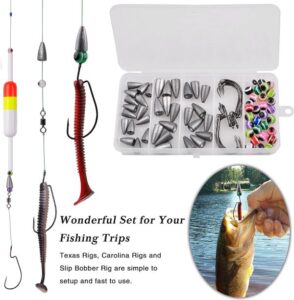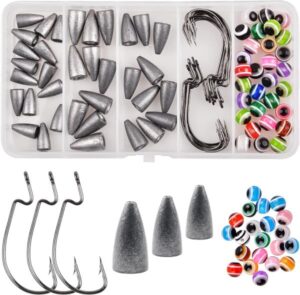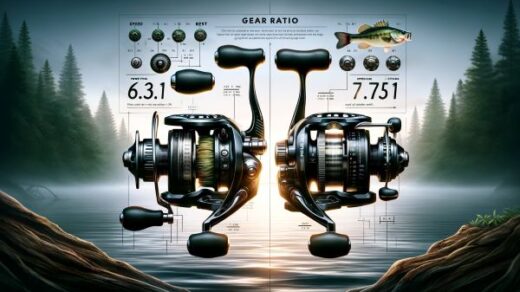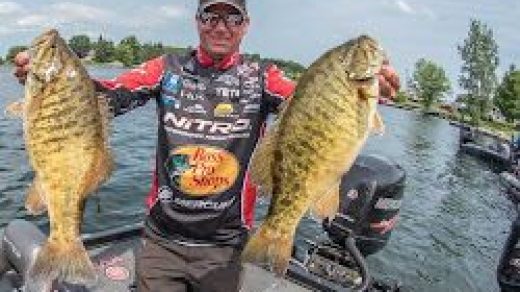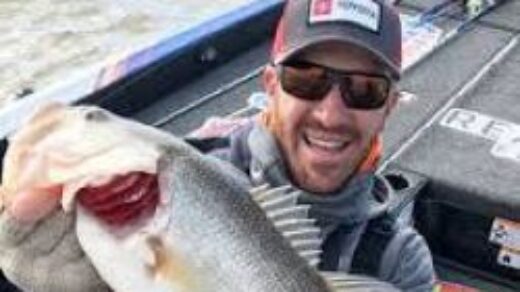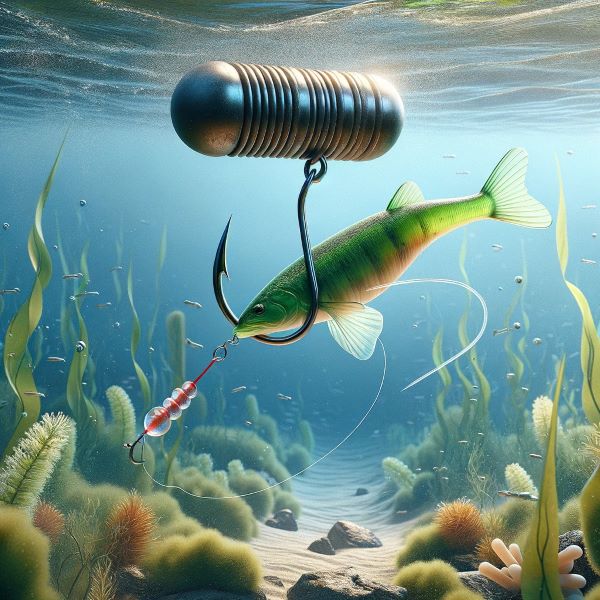
What is the texas rig?
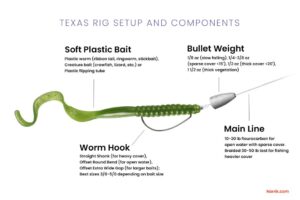 The Texas Rig is a popular fishing setup designed for bass fishing that allows the bait to move through water without getting caught in weeds or debris.
The Texas Rig is a popular fishing setup designed for bass fishing that allows the bait to move through water without getting caught in weeds or debris.
It involves a weight placed above the hook to sink the bait and give it a natural movement, making it ideal for targeting fish in a variety of underwater habitats, including heavy cover areas.
Fishing enthusiasts know the Texas Rig as a cornerstone technique in bass fishing, renowned for its effectiveness and versatility across varied underwater landscapes.
This ultimate guide delves into the intricacies of the Texas Rig, providing anglers with the knowledge to harness this method’s full potential, whether navigating weed-infested waters or aiming for the elusive bass.
Setting Up Your Texas Rig – A Step-by-Step Guide
The foundation of a successful Texas Rig begins with its setup. The right hook and weight can make a significant difference in your fishing outcomes.
For starters, selecting a hook that complements the bait size and pairing it with the appropriate weight ensures a natural presentation, crucial for attracting bass.
This segment will cover everything from the ideal hook selection, weight placement, and the significance of creating a weedless setup, ensuring your rig glides seamlessly through vegetation.
Setting up a Texas Rig involves a few simple steps to prepare your lure for effective bass fishing, especially in areas with lots of cover like weeds or submerged logs. Here’s a step-by-step guide to get you started:
- 1. Gather Your Materials: You’ll need a soft plastic bait (such as a worm, lizard, or creature bait), a hook (offset worm hooks are commonly used for Texas rigs), a bullet weight (the size depends on your fishing conditions), and your fishing line.
- 2. Slide the Bullet Weight onto Your Line: Begin by sliding the bullet weight onto your fishing line, pointy end first, so that it can move freely up and down the line. This weight will help your bait sink and give it a natural movement in the water.
- 3. Tie the Hook to Your Line: Using your preferred fishing knot, tie the hook onto the end of your line. The Palomar knot is a popular choice for its strength and simplicity.
- 4. Rig the Bait: Start by piercing the top of the bait with the hook point, about a quarter inch from the bait’s head. Push the hook through the bait and out the other side. Slide the bait up the hook toward the eyelet, rotating it so the head sits against the eyelet. This is where the “Texas” part comes in, making the setup weedless.
- 5. Embed the Hook Point: Once the bait’s head is snug against the hook’s eyelet, you’ll need to determine where the hook point should come back through the bait for a weedless setup. Bend the bait slightly to find the spot where the hook should emerge if it were straight.
- Then, push the point through the bait and out the other side. For a truly weedless presentation, pull the bait forward slightly and tuck the hook point back into the body, ensuring it’s barely covered by the bait material.
- 6. Adjust for Weedlessness: Ensure the bait is straight on the hook to avoid spinning, which can turn fish off. The bait should look natural and streamlined. The hook point should be just under the surface of the bait, making it weedless yet easy for the hook to set when a fish bites.
- 7. Final Check and Adjustments: Give your rig a final check. The weight should slide freely, allowing you to fish through cover without hang-ups, and the bait should be rigged straight for the best presentation and action in the water.
That’s it! You’ve successfully set up a Texas Rig. This setup is great for fishing in areas with lots of snags or vegetation because it minimizes the chances of getting caught up while still allowing the bait to move enticingly through the water, attracting bass.
Practice makes perfect, so don’t hesitate to adjust your rig as you see fit based on the conditions you’re fishing in.
Enhancing Your Fishing Success with Advanced Techniques
Beyond the basic setup, mastering the Texas Rig requires an understanding of advanced techniques tailored to different fishing environments.
This guide will explore strategies for maximizing the rig’s effectiveness, focusing on adapting to various conditions such as clear vs. murky water and fishing in heavy cover vs. open water.
Learn how to adjust your retrieval speed, the importance of the rig’s presentation, and how to interpret underwater structures to position your bait enticingly.
Maximizing the effectiveness of the Texas Rig requires a deep understanding of how to adapt your approach to different fishing conditions.
Whether you’re casting into clear or murky waters, navigating through heavy cover, or fishing in open water, the key to success lies in your ability to fine-tune your rig and techniques.
Here’s a guide to help you enhance your Texas Rig fishing skills:
Adapting to Water Clarity
- Clear Water: In clear water conditions, bass can be more visually alert and cautious. Opt for lighter weights, smaller hooks, and more natural-colored baits that mimic the local forage.
The goal is to present your bait as subtly as possible to entice wary fish. Slow down your retrieval speed to give bass a longer look at your bait, increasing the chances of a strike.
- Murky Water: In stained or murky waters, bass rely more on their lateral line to detect prey. Here, you can use larger, brightly colored baits and heavier weights to create more disturbance and vibration in the water.
A faster retrieve can trigger reactive bites from bass using their heightened senses to hunt.
Fishing in Heavy Cover vs. Open Water
- Heavy Cover: The Texas Rig shines in heavy cover due to its weedless nature. When fishing around weeds, brush, or submerged structures, use a heavier bullet weight to punch through vegetation and get your bait down to where the bass are hiding.
A brisk, jerky retrieval motion can help your bait navigate through tight spots without getting snagged. - Open Water: In open water scenarios, a lighter weight may be more effective, allowing your bait to fall more slowly and naturally. This can be particularly effective in areas where bass are feeding on suspended baitfish.
Use a steady retrieve with occasional pauses and twitches to mimic wounded prey, appealing to the opportunistic nature of bass.
Adjusting Your Retrieval Speed
The retrieval speed can dramatically affect the success of your Texas Rig. A slow, methodical retrieve is often effective in cooler water or when bass are less active.
In warmer conditions or when bass are aggressively feeding, a faster retrieve with intermittent stops and starts can provoke strikes.
Pay attention to the behavior of the fish and adjust your speed accordingly.
Importance of the Rig’s Presentation
The presentation of your Texas Rig is crucial. Ensure your bait is rigged straight on the hook to mimic the natural movement of prey.
An off-kilter bait can spin unnaturally in the water, deterring fish. Experiment with different sizes and shapes of soft plastics to find what works best in your fishing conditions.
Interpreting Underwater Structures
Understanding how to read underwater structures is essential for positioning your bait effectively. Bass often use structures like rocks, fallen trees, and weed beds as ambush points.
Use your knowledge of the water body and any available technology (like sonar) to identify these hotspots. Cast beyond the structure and retrieve your bait past it, mimicking a fleeing or foraging creature. This strategy can trigger instinctive strikes from predatory bass.
By mastering these strategies and learning to adapt your Texas Rig setup and approach to various conditions, you’ll enhance your ability to target bass more effectively.
Remember, the key to success with the Texas Rig, as with any fishing technique, lies in observation, adaptation, and practice.
Conclusion
The Texas Rig is more than just a fishing technique; it’s a skill that, once mastered, can significantly enhance your angling success. By understanding the nuances of setup and learning to adapt to various environmental challenges, anglers can unlock the true potential of this versatile rig.
Remember, the key to mastery lies in practice and experimentation, so don’t hesitate to try different combinations of gear and techniques to discover what works best for you and the specific conditions you face.
Embrace the journey of becoming a Texas Rig expert, and may your fishing adventures be fruitful and fulfilling.
This comprehensive guide aims to equip you with the knowledge and skills needed to master the Texas Rig, ensuring your next bass fishing excursion is your most successful yet.
